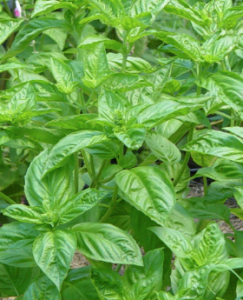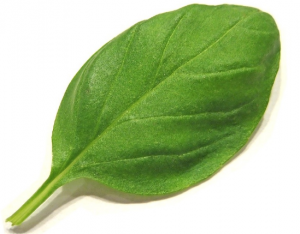If your garden is like mine, your basil is at this point more of a bush than a plant! Mine started producing early and hasn’t let up. After a brief lull in the very hottest part of the late spring, I thought we might get burnt. But basil is incredibly resilient and like most near weeds it’s hard to kill. From the constant kitchen use at The Sage Rabbit to quarts of pesto for a menu item, you would think the poor plants would be exhausted.

The truth be told its better to selectively and constantly trim your basil than to let it grow out. It spends less energy that way, and you get more uniform leaves.
What you also get is an abundance of basil and some pressure to use it on a regular basis. Of course, pesto comes to mind immediately, or a nice Caprese salad, but what else fits the flavor profile of the herb; Its spice, the grassiness backed with a tartness, and the overwhelming floral aromas either freshly picked or in a finished dish?
The choices are varied and diverse and connect seemingly disparate cuisines tightly together. Basil is like garlic and onion and other well-known flavors. The profile is too familiar to really hide it anywhere. What we can do is multi-purpose our basil in less than mainstream ways.

Forget the pesto for a moment, try a mix of sambal, basil, ginger, and garlic, fried in a bit of sesame oil. Add some peanuts or peanut butter to the mix and blend it with lime juice to make a peanut sauce for rice noodles. The basil gives the sauce a unique anise quality that blends well with the ginger. The sambal, a chili pepper paste common to Asian cuisine has enough tartness and heat to blend with the pepperiness of the basil without overpowering it. Adding in the element of fat, in the form of peanut butter, and cleaning everything up with a little lime juice balances everything else. The result is a unique blend of flavors that is familiar and slightly exotic in the same dish.
I like the sweet side of basil as well, the sliver of flavor that blends well with fresh berries, and opens the herb up to pairings with chocolate, aged balsamic and even custards. Common to the Italian cuisine, the use of herbs with berries is well documented. Less so is the combination of chocolate and herbs, most notably dark chocolates and more aggressive herbs like rosemary and basil.
Infusing the herb in a ganache, to pour over an almond cake is far more common in the Mediterranean than it is here. Mixing in a chocolate nougat with basil oil or essence cleans up the muddy flavors that sometimes results in a rich dish. Looking for the same sweet pairing on the savory side takes a bit more work, but recently I think I’ve found a good medium to accomplish this. Cream and butter in place of olive oil soften the sharp edges of freshly picked basil.

In a dish that wants the floral over the bite cream infused with basil or butter to finish a sauce with basil gives me all the flavor and some of the bite all the while filling the palate with the warmth of summer. Add in some corn, some roasted tomato or smoked onions and the sweetness of the herb comes across more strongly.
Because the flavor of basil is so recognizable, it can be taken for granted. Tossing some pasta in January with a jar of basil pesto may temporarily satisfy your cravings, but it doesn’t begin to equal the impact of fresh summer basil. And if you do a little more tasting and testing you will see that between varieties and even seasons there are subtle changes in the way the herb tastes. Hot and dry brings out an edge to the plant, making the pepper come through, early summer, late spring moisture will keep the flavors fresh, but softer.
Late August, after a long season of trimming and picking, will yield the most diverse flavor profile of all, ranging earthy and dark to bitter and sharp. This is the time to watch your choice of dishes to work with. Basil pesto made in the early to midsummer is the best, to take the end of the summer basil, puree it and then freeze it is to bring out all the sharpness that the tired plant can muster.
Whatever choices you make for your basil, don’t settle for the tried and true recipes. They do comfort initially, but you can only eat so many Caprese salads before you don’t appreciate them as much. Slip some basil into your desserts, with some nice balsamic and peaches, slide it under the skin of your chicken before you roast it and let the flavor bloom. If basil is your herb, let it loose, it won’t disappoint.
Paris in Saigon Peanut Sauce
½ cup ginger chopped
½ cup garlic chopped
½ cup tightly packed basil leaves
½ cup sesame oil
2 Tbl. Sambal
1 cup rice wine vinegar
1 and ½ cups water
2 cups peanut butter
1 cup soy
Juice of 3 limes
Gently fry the ginger, garlic and basil in the sesame oil being careful not to burn it. Add in the sambal and the rice wine vinegar and let it simmer for 5 minutes. Remove the ingredients to a food processor or blender and start blending the ingredients. Add in the water and soy to keep the process moving, alternating the peanut butter with the liquid. Finish the sauce with the lime juice.

John Foster is an executive chef who heads the culinary program at Sullivan University’s Lexington campus. A New York native, Foster has been active in the Lexington culinary scene and a promoter of local and seasonal foods for more than 20 years. The French Culinary Institute-trained chef has been the executive chef of his former restaurant, Harvest, and now his Chevy Chase eatery, The Sage Rabbit.
To read more from Chef John Foster, including his recipes, click here.
























